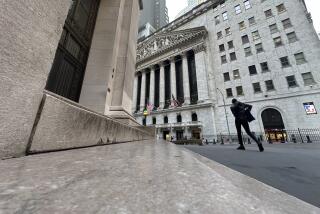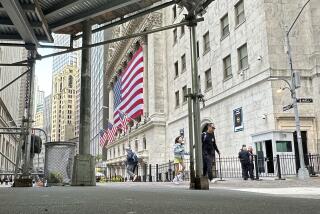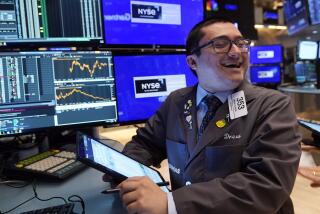Stocks Stage a Recovery Amid Bargain-Hunting
Key market indexes staved off a third straight decline Thursday after a wave of bargain hunters challenged Wall Street’s pervasive pessimism, sparking a late-afternoon rebound.
The recovery allowed the blue-chip Standard & Poor’s 500 index to once again avoid finishing in bear-market territory, which many experts define as a drop of more than 20% from the index’s peak.
The S&P; was down more than 2% at its low for the day, pushing it to a 20.4% loss from its record closing high, reached last March. But it rallied to close with a 1.29-point, or 0.1%, gain to 1,241.23.
The Nasdaq composite index, which has been deep in its own bear market for months, erased an 80-point intraday loss to close up 31.54 points, or 1.5%, at 2,183.37. That still left it down 57% from its high reached a year ago.
The Dow Jones industrial average rallied from a 192-point deficit but ended down 45.14 points, or 0.4%, at 10,450.14.
Besides bargain hunting, other catalysts contributed to the rebound, traders said. Applied Micro Circuits’ stock rallied from its lows, closing up $2.81 at $29.56, despite a downward earnings revision by the communications chip maker. The rebound seemed to bolster the tech sector.
In addition, IBM gained $6.94 to $106.05. The company told analysts it was making no changes to its expectations for 2001 earnings--a rarity among tech firms lately.
Other tech shares leading Nasdaq back included KLA Tencor, up $3.69 to $39.44; Check Point Software, up $7.19 to $71.31; and JDS Uniphase, up $2.50 to $29.25.
There also was “short-covering,” or buying of stocks by traders who were replacing borrowed shares they had previously sold, betting on price declines.
Yet time and again over the last six months, market rallies have been quickly crushed by renewed selling. Investors’ wariness stems from the flagging economy, a sharp slowing in earnings growth across corporate America and, this week, disappointment that the Federal Reserve didn’t rush to cut interest rates again to reignite the economy.
Indeed, the parade of stocks getting hammered because of earnings warnings continued Thursday, with personal-computer maker Gateway, down $1.45 to $15.75, and networking-equipment builder 3Com, down $1.63 to $7.50, the latest casualties.
Yet some analysts took solace from the fact that, for the second week in a row, the bulls have refused to go quietly and prevented the S&P; 500 from closing below the bear-market threshold.
“It’s not an all-out bear situation right now,” said Tim Hayes, global equity strategist at Ned Davis Research in Venice, Fla.
The 20%-loss definition of a bear market is an arbitrary one, and some analysts don’t subscribe to it.
“There are bear markets that have been short and deep, and ones that have been long and shallow,” noted Hugh Johnson, chief investment officer at First Albany Corp. “It doesn’t make any difference whether it [the decline] is 19% or 21%.”
Still, he and many others agree that a 20% decline in the S&P; 500 could be problematic because the notoriety surrounding such a pullback probably would exacerbate the pessimism already felt by many investors. The last official S&P; bear market was in 1990.
The index also fell to the 20% threshold in late summer 1998, amid economic turmoil in Russia and Asia, then quickly bounced back.
Some pros don’t believe that crossing the 20% mark would necessarily be a big deal. “I suggest that the chances of further declines in the market, just because we hit this number [of a 20% drop in the S&P; 500], are no greater than they were before,” said Steven Thorley, research director at Analytic Investors in Los Angeles.
Another trend concerns many Wall Streeters, though, and that’s the slow, grinding way that stock prices are eroding. Investors looking for a market bottom often wait for a cataclysmic sell-off on huge share volume, a capitulation among investors that clears the decks for the next advance.
But so far that hasn’t happened. Instead, it appears investors are gradually selling out as their frustration grows, analysts said.
“We’ve gone through a stage of denial, which has been very orderly,” Johnson said. “That tells me we have a ways to go [on the downside]. There just isn’t enough fear yet.”
By the close Thursday, losers held a slight edge over gainers on the New York Stock Exchange, and a 22-to-16 edge on Nasdaq. Trading was heavy but nowhere near record levels.
Among the nontech stock sectors gaining Thursday were energy, food stocks and insurance issues, while airlines and retail shares were mostly lower.
Elsewhere, Treasury bond yields closed mixed. The yield on the two-year T-note rose to 4.44% from 4.40% Wednesday, but the 10-year T-note yield eased to 4.88% from 4.91%.
*
Reuters news service was used in compiling this report.
Market Roundup: C7, C8
More to Read
Inside the business of entertainment
The Wide Shot brings you news, analysis and insights on everything from streaming wars to production — and what it all means for the future.
You may occasionally receive promotional content from the Los Angeles Times.











